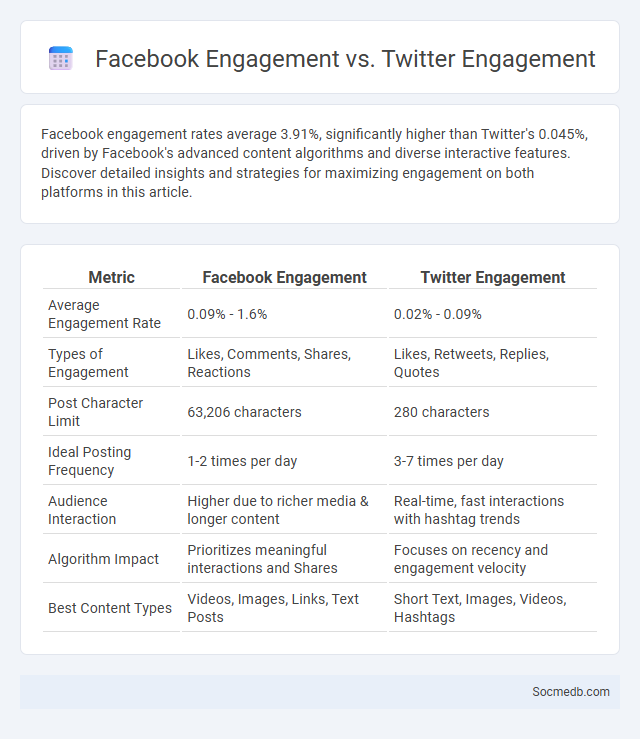
Photo illustration: Facebook Engagement vs Twitter Engagement
Facebook engagement rates average 3.91%, significantly higher than Twitter's 0.045%, driven by Facebook's advanced content algorithms and diverse interactive features. Discover detailed insights and strategies for maximizing engagement on both platforms in this article.
Table of Comparison
| Metric | Facebook Engagement | Twitter Engagement |
|---|---|---|
| Average Engagement Rate | 0.09% - 1.6% | 0.02% - 0.09% |
| Types of Engagement | Likes, Comments, Shares, Reactions | Likes, Retweets, Replies, Quotes |
| Post Character Limit | 63,206 characters | 280 characters |
| Ideal Posting Frequency | 1-2 times per day | 3-7 times per day |
| Audience Interaction | Higher due to richer media & longer content | Real-time, fast interactions with hashtag trends |
| Algorithm Impact | Prioritizes meaningful interactions and Shares | Focuses on recency and engagement velocity |
| Best Content Types | Videos, Images, Links, Text Posts | Short Text, Images, Videos, Hashtags |
Understanding Social Media Engagement
Social media engagement encompasses likes, comments, shares, and followers that indicate user interaction with content across platforms like Facebook, Instagram, and Twitter. High engagement rates often signal strong audience interest and brand loyalty, driving organic reach and improving algorithmic visibility. Tracking engagement metrics using tools such as Hootsuite or Sprout Social enables businesses to refine content strategies and boost overall social media performance.
Facebook Engagement: Key Metrics
Facebook engagement is measured through key metrics such as likes, comments, shares, and click-through rates that indicate how users interact with your content. Monitoring these metrics helps you understand audience preferences and optimize posts to increase visibility and reach. Tracking engagement rates per post provides insights into content effectiveness and aids in refining your social media strategy.
Twitter Engagement: Key Metrics
Twitter engagement is measured primarily through metrics such as retweets, likes, replies, and mentions, which indicate audience interaction and content resonance. Tracking engagement rate, calculated by dividing total interactions by the number of impressions, provides insight into how effectively tweets capture audience interest. Analyzing follower growth alongside these metrics helps optimize content strategy for maximum reach and influence.
Core Differences Between Facebook and Twitter Engagement
Facebook engagement thrives on rich multimedia posts, community building, and detailed user interactions such as comments, shares, and reactions, which foster deep connections within groups and pages. Twitter's engagement centers around real-time conversations, brief text updates, hashtags, and retweets, promoting quick information dissemination and broader visibility. Understanding these core differences helps you tailor your social media strategy to maximize engagement effectively on each platform.
Content Types That Drive Facebook Engagement
Video content consistently drives higher Facebook engagement by capturing attention through dynamic storytelling and visual appeal. User-generated content encourages interaction and builds community trust, boosting your brand's visibility. Polls and interactive posts prompt direct audience participation, increasing reach and fostering meaningful connections.
Content Types That Drive Twitter Engagement
Visual content such as images, GIFs, and videos significantly boost Twitter engagement by increasing retweets and likes. Polls and questions encourage direct interaction, fostering community participation and prolonged conversations. Hashtags linked with trending topics and concise, impactful text further enhance visibility and user involvement on the platform.
Audience Behavior on Facebook vs Twitter
Facebook users typically engage with content through likes, comments, and shares within private or closed communities, reflecting a preference for deeper social interactions. Twitter audiences prioritize real-time updates and concise messaging, favoring retweets and hashtag-driven conversations for quick information dissemination. The distinct interaction patterns highlight Facebook's focus on personal connections, while Twitter emphasizes public discourse and trending topics.
Engagement Strategies Unique to Each Platform
Effective social media engagement strategies vary significantly across platforms, with Instagram thriving on visually appealing, hashtag-rich posts, TikTok leveraging short, creative videos and trending sounds, and Twitter excelling in real-time conversations and timely hashtags. Your content should be tailored to fit the specific audience and algorithmic preferences of each platform, such as using Instagram Stories for interactive polls, TikTok's duets feature for collaboration, and Twitter's threaded tweets for in-depth discussions. Understanding these unique tactics enhances your ability to connect authentically and boost engagement metrics on each channel.
Measuring and Comparing Engagement Effectiveness
Measuring and comparing engagement effectiveness on social media involves analyzing metrics such as likes, shares, comments, and click-through rates to gauge audience interaction. Your ability to track these key performance indicators across different platforms enables you to identify the most impactful content and optimize future strategies. Leveraging tools like social media analytics dashboards and engagement rate formulas ensures a data-driven approach to enhancing your online presence.
Choosing the Right Platform for Your Engagement Goals
Selecting the right social media platform depends on your specific engagement goals, such as brand awareness, lead generation, or customer interaction. Platforms like Instagram and TikTok are ideal for visual and younger demographics, while LinkedIn suits B2B connections and professional networking. Understanding audience behavior and platform algorithms enhances targeted content delivery and maximizes user engagement effectively.
 socmedb.com
socmedb.com